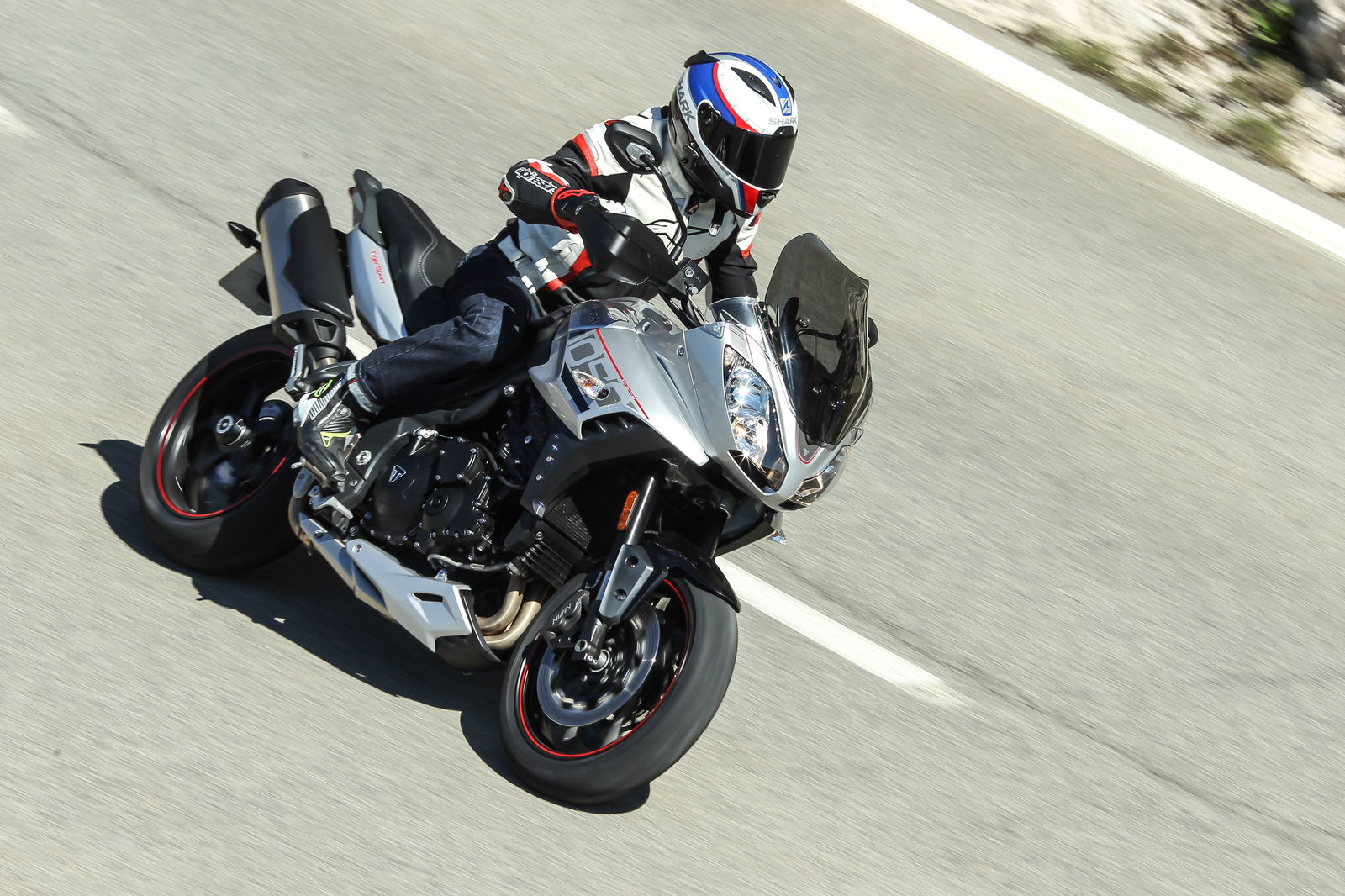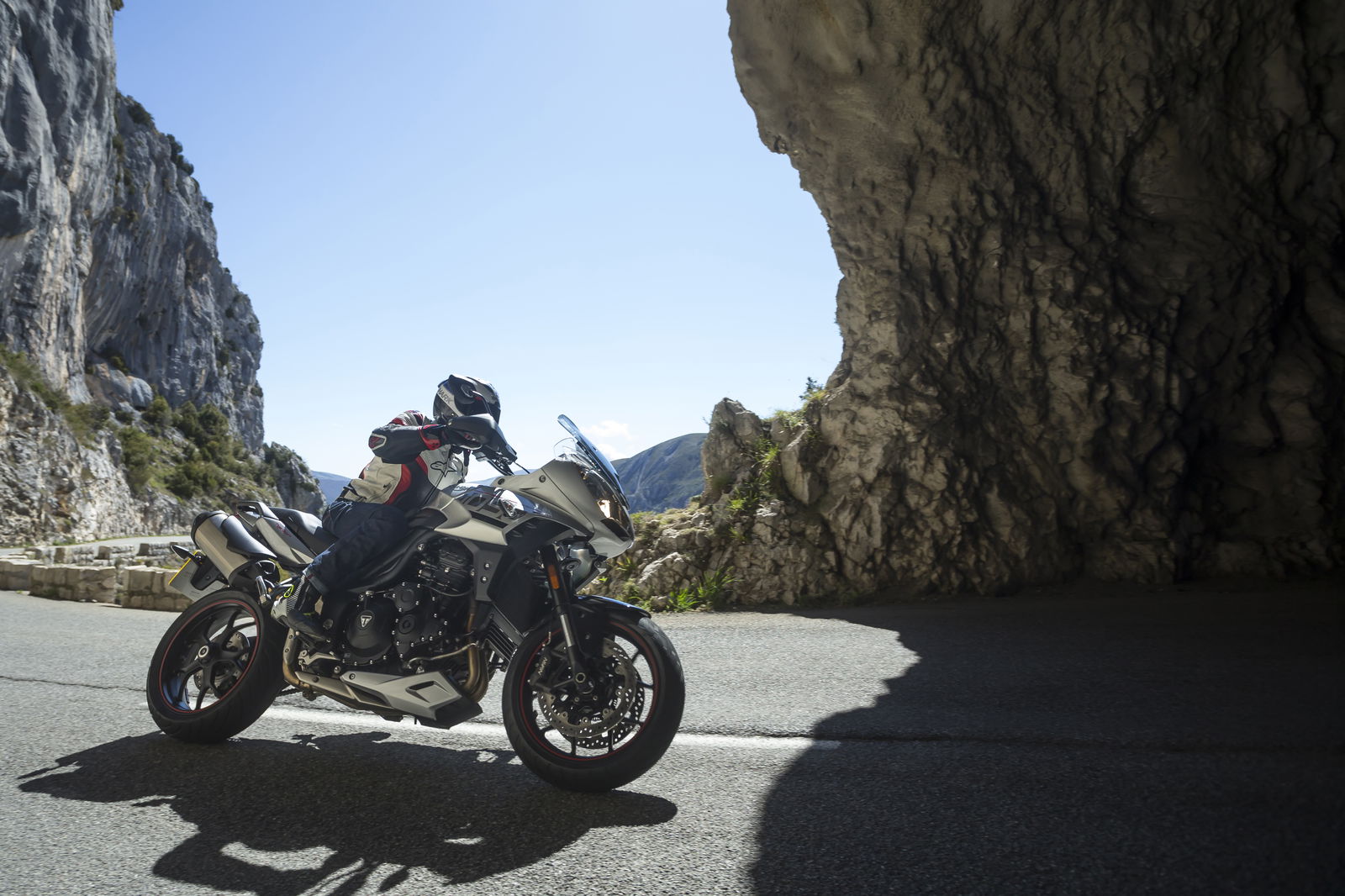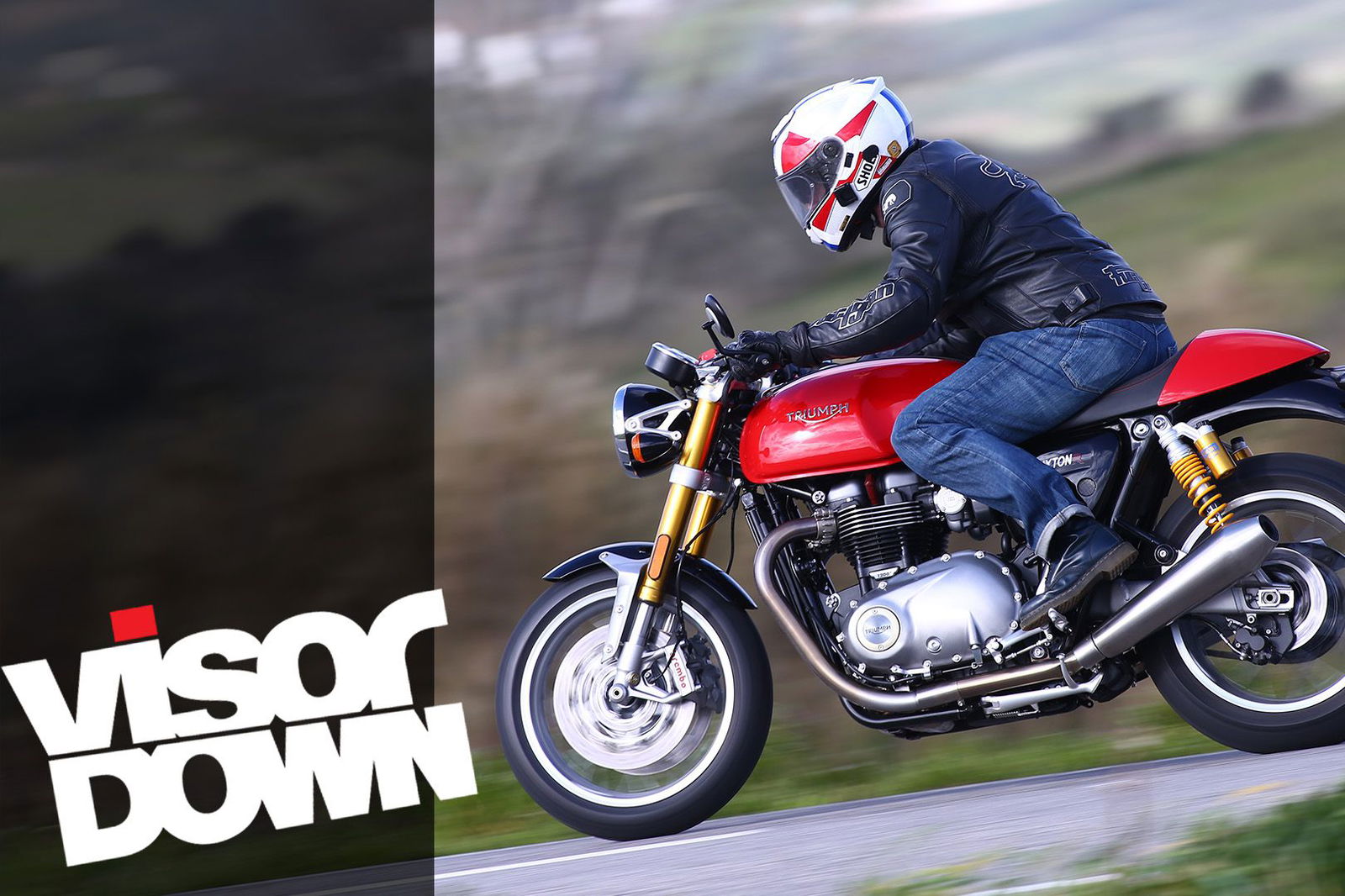First ride: Triumph Tiger Sport review
The purrfect all-rounder?


ARRIVE at the location. Take Dictaphone and notepad to a presentation to record what’s new, interesting, noteworthy, lighter, more powerful and sexier about the new model. Offer a prayer for sweet roads and sunny skies. Go to bed. Get up and ride the bike, keeping in mind the changes I was told about the previous day and focusing my attention on them.
That’s the usual format for a bike launch.
Triumph doesn’t work like that – in fact they wouldn’t give us the facts and figures about the updated Tiger Sport until after we’d ridden it. Even during the ride, when stopped for coffee, trying to elicit any kind of figures from the Triumph PR men resulted in evasive answers and sentences that trailed off.
But before swinging a leg over the new Triumph Tiger Sport, I do know a few choice nuggets such as the fact that it’s powered by the new 1050cc engine from the 2016 Speed Triple, which has 104 changes over the old one (including a new cylinder head, inlet ports and piston design) which is claimed to provide more torque and improved fuel economy.
It’s also now got traction control and riding modes. Elsewhere there’s a taller, adjustable screen and a host of smaller changes like new mirrors and grippier pegs.
Still, when I ride the bike, some of the juicy stuff – price, power, weight and engine details remains a tantalising mystery.
Setting out for the day, I’ve got no choice but to accept that I'm not equipped with the cold hard facts. As I squirt along a road that gently hugs the side of the Gorges du Verdon near Nice, 10 minutes in to the ride, I don’t yet know what Triumph’s engineers have done to the engine, but I’m sure that once I’ve handed the keys back they’ll be telling me that in this bike the new 1050cc three-cylinder motor doesn’t have the same 140hp it does when it’s in the new Speed Triple.
I’m right – the new Triumph Tiger Sport makes 126hp at 7,000rpm and 78.1lb/ft at 9,475rpm and although the engine is detuned, what’s on offer is all easily there for the taking. Triumph wants the new Tiger Sport to be the most versatile motorcycle going and the beating heart of that philosophy is the engine, which is very versatile and happy pulling you along in a high gear, or being worked with the needle higher up the rev range.
When I stick it in sixth at just over 30mph, the engine’s ample torque hauls me forward and although there’s drive present from what feels like nothing, the engine is at its most fun between 6,000 and 9,000rpm, when opening the taps delivers a creamy and comprehensive glut of forward motion.
Keener mathematicians among you will note that the number three sits between two and four. Without meaning to sound clichéd, the Tiger Sport’s three-cylinder engine does possess a nice blend of V-twin-style grunt, but is also happy to let me pretend it’s got one additional cylinder thanks to the fact that it revs so freely and is rewarding to keep spinning in the higher reaches of its rev range to deliver peak power just before 10,000rpm.
Triumph says it’ll return 54mpg and after a long day in the saddle (when for the most part I wasn’t being at all economical with the engine) it returned 45.9mph, I’m inclined to think Triumph's quoted figure isn't an outrageous claim. Certainly on straight 60-80mph stretches of road when I could leave it in sixth gear, the MPG display was telling me I was getting up to 60mpg. The tank holds 20 litres of motion potion - that's the same as the Suzuki V-Strom 100 Sport , 2 litres more than the Yamaha MT-09 Tracer and one less than the Kawasaki Versys 100.
It sounds pretty good too, and although the exhaust silencer looks the same as the one on the outgoing model, it’s been redesigned inside, so now only has one chamber rather than three, which of course I’d guessed during the ride. The Tiger Sport has a new airbox (different to the Speed Trip’s) and its soundtrack is aided by the fact that it makes a nice induction noise when the throttle is cracked with a bit of gusto, so when it’s being ridden hard, it begins to roar like some kind of big cat…
For the most part it fuels really nicely and thanks to a nice throttle action and response, the engine worked in absolute harmony with my right hand on the bit of the handlebar that makes things blurry. It wasn’t perfect though and had a slight flat spot at just over 5,000rpm, when the otherwise cleanly building power momentarily, and almost imperceptibly paused for breath before resuming its surge.
One of the things we knew about the new Tiger Sport before Triumph officially presented us with detailed information about the bike is that the engine is tempered by a new set of electronics, so along with the ABS present on the old model, it now has traction control and three ride modes - rain, road and sport. A button next to the clear LCD information display switches between modes but only when the throttle is shut and the clutch is pulled in. Why not just make it easier to do on the go by putting the switch by the bars?
The throttle map changes between each mode, softening or sharpening up the response from the engine accordingly. Road and sport modes both have full power, while rain is capped to 100hp and has more traction control.
Traction control is the same in road and sport modes. Triumph calls it ‘progressive’. Coming out of the first, second and third gear corners on our route to the west of Nice could easily result in the TC light flickering away on the dash, with no perceptible loss of drive. Other times, I could feel it being more intrusive in cutting power for a second or two when I was leant over and opening the gas.

After a couple of hours, myself and the other UK journos are stopped having café au lait and a menages au trois (that’s a type of pastry, right?) when the guys from Triumph pile out of a van to find out how we’re getting on. I tell them I like it (I do) and then during the course of my conversation with a man in a Triumph t-shirt, I casually try to find out how much it costs. I’m nearly successful – ‘Ten thousand….’ is all I get before Mr Triumph stops himself short and tells me I’ll have to wait until after the ride.
Patience isn’t a virtue I possess, and in case you don’t either, here it is: the new Triumph Tiger Sport costs £10,300 on the road, irrespective of which colour (silver or black) you choose. That means it’s £551 more than the base model Kawasaki Versys 1000, which costs £9,749. It’s also more expensive than the £9,799 Suzuki V-Strom 1000 Sport, and £8,149 Yamaha MT-09 Tracer but it is cheaper than the Aprilia Caponord Rally, which costs £14,136.
It turns out that a hit of caffeine is a good idea because once away from the coffee shop, the roads get more demanding and shine more a spotlight on the Tiger’s capable brakes, chassis and suspension.
It’s nicely suspended with a set of Showa USD forks (adjustable for preload, rebound and compression damping) and a Showa monoshock (adjustable for preload and rebound damping). It’s the same stuff that’s on the old bike. This is a sports tourer so I’d expect it to be comfortable and it definitely is, in fact, it’s got a lovely, cushy and well controlled ride and that adjustability means it can be fine-tuned to suit you or your riding style. The suspension just quietly gets on with doing a good job of making the bike feel well connected to the road. The result is a ride that feels sporty yet sumptuous, with suspension calmly tracking the road surface and allowing the Pirelli Angel GT tyres to do their thing. The Tiger never felt wallowy or sloppy, regardless of speed or how quickly I was trying to turn, accelerate and brake.
There’s brutish braking on tap from the front twin four-piston radial-mounted Nissin calipers and 320mm floating discs. The Tiger isn’t over-braked but bestowed with a really nice set of stoppers which never failed to deliver sharp bite, a lot of power and good feel. They’re well up to the job of reining in the engine and mastering the bike’s claimed 218kg dry weight.
It’s difficult to compare bike weights but to give you a flavour, kerb weights for the Versys and V-Strom are 250kg and 228kg respectively, both of which are bested by the MT-09 Tracer’s 210kg wet weight (which is full oil and a full tank).
Handling wise, it’s effortless and compliant - easy to pitch in to a long, sweeping corner and nimble through town too. On some of the more twisty road I was on, it was light and easy to get stopped, turned and away from a corner and that’s because the suspension is good and the bike is well balanced, planted and sure-footed.
The riding experience offered by the Tiger Sport definitely manages to cover a few bases and it’s a bike that could be used for commuting, weekend blasts and crossing borders in to lands unknown, and to that end it’s designed to be a comfortable bike to spent time on.
The seat is nicely shaped and I enjoyed the way I seem to slot right onto it (although it feels like a bike you sit in). The riding position is upright but relaxing and it felt during all the riding I’ve described so far. The adventure bike-style riser bars fall nicely to hand and feature sets of switches that move with reassuring clicks and clunks when pressed.
There’s decent wind protection from the new adjustable screen. Triumph says it can be adjusted with one hand on the move, which is true, but it takes a bit of wiggling and pulling to raise it up. Getting down is no problem though. The hand guards (which are standard) also keep the wind off hands and this’ll no doubt be useful in the winter, but you’ll need to spend a bit more on Triumph’s heated grips if you want to make things really toasty.
Cruise control is another feature designed to make the Tiger Sport more comfortable and easy to use, but I couldn’t get on with it. The switches to active and set the cruise control are located on the right side of the handlebar and while setting it was easy, so was accidentally turning it off when I moved my thumb back round the twist grip to firmly hold the bar once again because nudging the throttle forward cancels the system. I found it fussy to get set and keep running unless I was being very delicate with my right hand.
The mirrors were consistently affected by vibrations and whenever I looked in them to see who was riding behind me, all I was able to see was a fuzzy bike-shaped object.
The bike is made at Triumph’s factory in Hinckley and it stood up well to close inspection because it feels like a quality machine. Little things tell you this – the good quality engine bolts, the satisfying click when the pillion pegs move out, the action of the filler cap key cover, the lustre of the paint, the textured crankcase covers, the new graphics and badges.
Free from fatigue and back at the hotel after a day riding the 2016 Triumph Tiger Sport, the presentation finally got started. With the addition of the expected slice of marketing speak, it articulated that Triumph’s brief for this update was to instil the Tiger Sport with the perfect versatility.
Perhaps that’s why they wanted us to ride it first - so we could discover how Triumph has built on the Tiger Sport’s existing all-round qualities, and when the 2016 bike’s versatility and capability is so evident across so much of the bike, and in a range of different situations, it’s hard not to notice.
CLICK HERE TO WATCH OUR VIDEO REVIEW OF THE TRIUMPH TIGER SPORT
Model tested: Triumph Tiger Sport
Price: £10,300 OTR
Engine: 1050cc liquid-cooled, 12-valve, DOHC, three-cylinder
Power: 126hp at 7,000rpm
Torque: 78.1lb/ft at 9,475rpm
Weight: 218kg dry
Suspension: Front – Showa USD forks adjustable for preload, rebound and compression damping / Rear – Showa monoshock adjustable for preload and rebound damping
Brakes: Front - Twin Nissiin four-piston calipers with 320mm floating discs / Rear – Two-piston caliper, 255mm disc
Tyres: Pirelli Angel GT, 120/70 front, 180/55 rear
Fuel capacity: 20 litres
Seat height: 830mm
Colours: ‘Matte Jet Black’ and ‘Aluminium Silver’
Availability: In dealers on April 23

